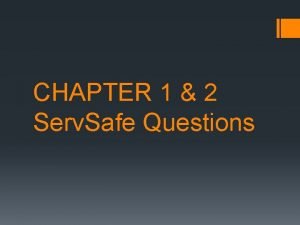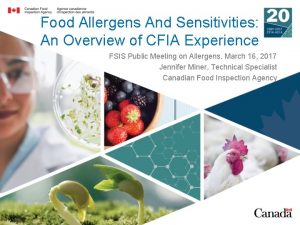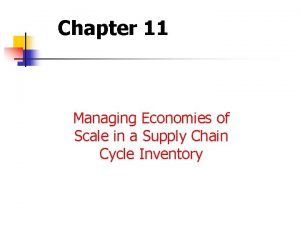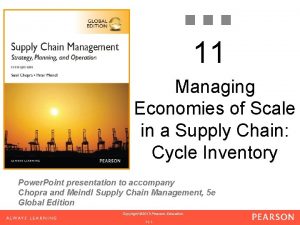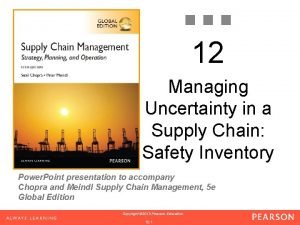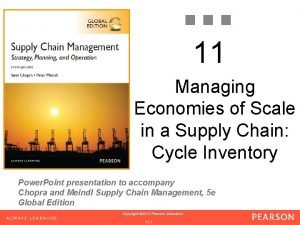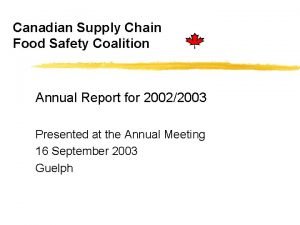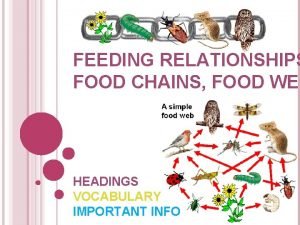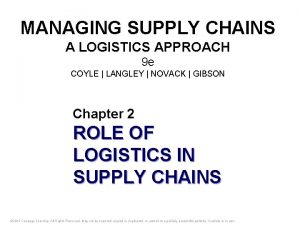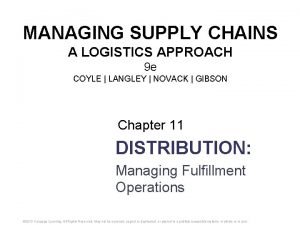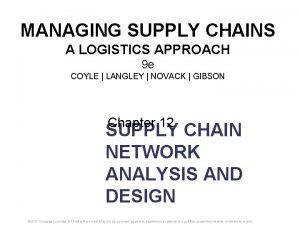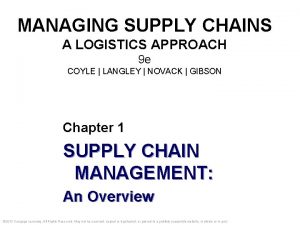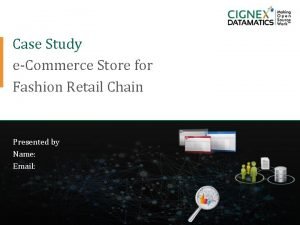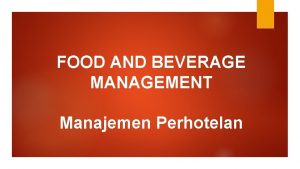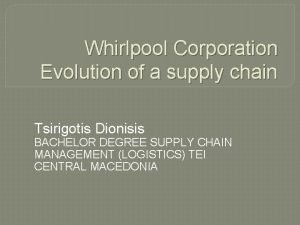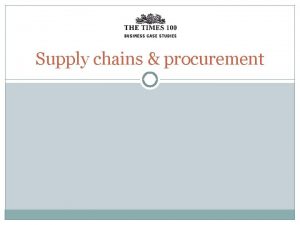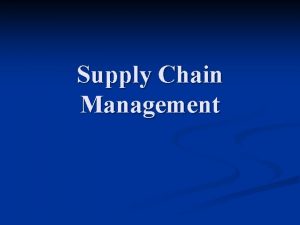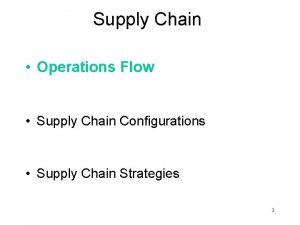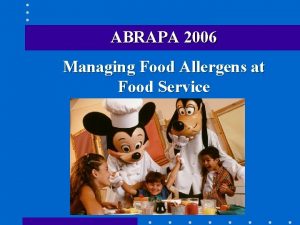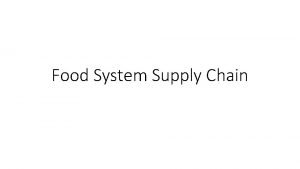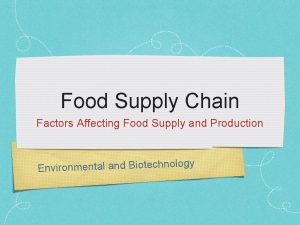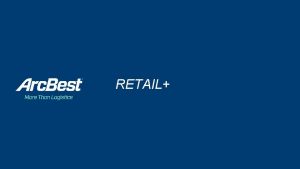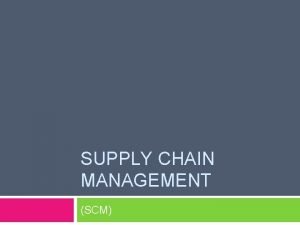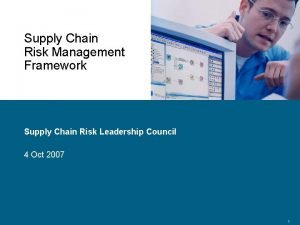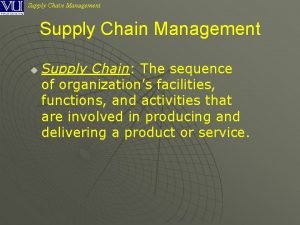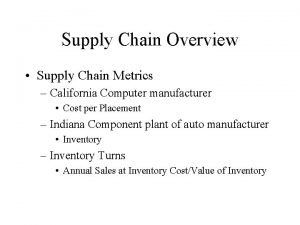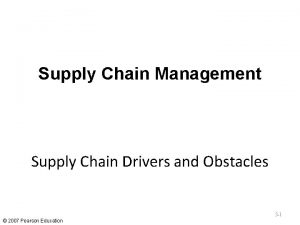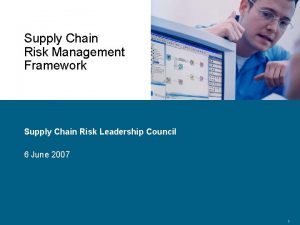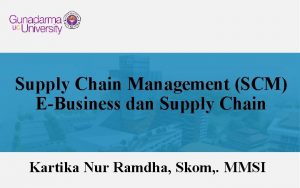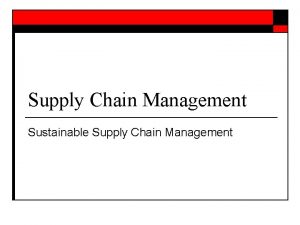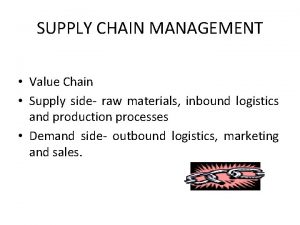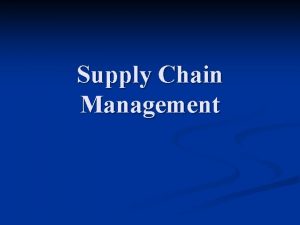Managing Food Allergens in the Retail Supply Chain




























- Slides: 28

Managing Food Allergens in the Retail Supply Chain John Points Consultant Scientist

Contents What do we mean – manage? Risk Assessment Risk Management Dealing with incidents

What do we mean – manage? Customers can be confident that if it is not on the label, it is not in the food. A non-competitive issue: consumer trust in food affects everybody

A significant risk to manage Worst-case impacts Fatalities / Hospitilisations Brand damage (long-term loss of trust) Product recall (Direct costs £ 100 K - £ 5 M)

What do we mean – retail supply chain?

Part of the retail supply chain Processed Raw Materials Simple Raw Materials Manufacturer’s Site Supermarket own-brand recipes Smaller specialist suppliers I will concentrate on own-brand manufacturing “Artisan” brands Retail Manufacturer’s branded product

How retailers assure standards Formal Standards – Specified in Trading Contracts Audit and Inspection (surveillance testing) (complaints trends) GFSI Certification Schemes Retailers’ own Standards Certification Bodies In-house audit team

Raw Materials - Allergenic Assessment BRC SALSA

Inventory of allergens on site

Typical visualisation Grid of which products contain which allergen (either as an ingredient or as an unavoidable RM cross-contaminant) Red – need to protect the product from any source of this allergen

Risk assessment – routes of contamination Some sectors have higher inherent risk than others – what can you control? Bakery Meat

Risk Management Does NOT mean Alibi Labelling Seen as protecting the retailer, rather than protecting the consumer Applied inconsistently – people no longer believe it (or, if they do, would overly restrict choice for those with allergies)

(unjustified “May Contain…. ” labelling will be precluded by BRC v 8, from February 2019)

Risk Management - Training Every new employee and contractor receives allergen management training before starting work

Risk Management - segregation

Risk Management – physical segregation Keep the allergenic ingredient away from non-allergenic products OR Keep the non-allergenic product away from everything else Storage Air-flows Tools & equipment People-flows

Risk Management – time segregation Manufacture products with allergenic ingredient AFTER those without Rigorous cleaning procedures before re-start of non-allergenic product

Cleaning Validation & Verification Mix of on-site test kits and laboratory tests – ensure no allergen is left on equipment or surfaces Sample Type Example Swabs From the inside of equipment, difficult to clean areas. Coats and workwear. Tools. Rinse water (or dry flushing material, for bakery) Cleaning-in-place. Conveyor washer. Air filters or settle plates Filters between dry powder separation areas Final product Test the first non-allergenic unit off the line, following re-start after clean Sometimes 30+ tests before the line restarts

Extra requirements for Free-From Depends on the Retailer’s Policy Some retailers don’t allow the allergen on site �or on any of the raw material suppliers sites Some allow it, but in separate buildings / lines Exceptions – uneconomic to have a separate line �e. g. gluten-free Christmas puddings �extensive cleaning and verification protocols All require extensive testing of RMs and product �some require positive-release testing

Despite all this …………. More cases of allergen recalls due to mis-packs than to cross-contamination Entirely avoidable Much more hazardous than cross-contamination (or – even more frustrating – allergen label not printed in the local language)

When the worst happens – what does a retailer do? All supermarkets have well-practiced and formal procedures for incident impact-assessment and control. (weekly occurrence, for the Big 4: no need for war-games practice!)

Retailer assesses the hazard and the impact Examples: increasing hazard, increasing impact Surveillance test result – trace of allergen found (may have been occurring for years!) Notification from supplier – weakness or failure in segregation or cleaning procedures Notification from supplier – confirmed trace contamination in a raw material batch Notification from supplier – weakness or failure in packaging inventory control system Notification from FSA or industry – confirmed allergen in competitor product from same supplier Discretion Confirmed mispack or customer complaint No discretion Retailer’s Options Continue sale – but fix the problem at source Stop supply – but sell through existing stock Point of sale hold– whilst investigating or assessing further Withdraw stock – but no publicity or recall Within discretion, different retailers have different approaches to publicity / recalls (brand protection vs erring on side of caution) Recall

Impact Assessment – Example Scenario Surveillance test finds unlabeled egg 10 -20 ppb in raw prawn crackers Used in a variety of foods across many ranges – snacks and ready-meals Calculations show that it breaches the VITAL 2 limit But: Products have been on sale for years – no reported complaints Huge analytical uncertainty on test result – different test kit detects no egg Recall would be massive – range of products, volume of sales, long shelf-life Withdraw or recall? Only have a few hours to make the decision

Recalls – a slick process Pre-written communication: FSA, other retailers, allergy action groups Pre-written templates: in-store notices, press releases Automated point-of-sale blocks Loyalty card data – direct e-mail to customers who bought the product (~40% return rate, compared to ~20% for press-release notices) Pre-written briefs for customer careline operators, store managers Avoid drip-by-drip recalls: one recall notice, all affected products, industry-wide.

Is it effective? UK fatal allergens have been catering, not retail (touch wood)

Is it consistent? Incidents as collated on https: //horizon-scan. fera. co. uk, data analysis by John Points

Summary Allergens are well-controlled in UK retail � given the volume of sales, there are relatively few incidents Certification and assurance schemes give consumers confidence Even with the best schemes, incidents still happen � Procedures to deal with incidents are effective and fast Retailers need to make major decisions on uncertain analytical data

Thank You john. points@btinternet. com
 Sequence of food chain
Sequence of food chain A food handler stored a sanitizer spray bottle
A food handler stored a sanitizer spray bottle 14 allergens ireland
14 allergens ireland Allergens cfia
Allergens cfia Managing economies of scale in a supply chain
Managing economies of scale in a supply chain Managing economies of scale in a supply chain
Managing economies of scale in a supply chain Role of safety inventory in supply chain
Role of safety inventory in supply chain Managing economies of scale in a supply chain
Managing economies of scale in a supply chain Matching supply and demand in supply chain
Matching supply and demand in supply chain Difference between logistics and supply chain
Difference between logistics and supply chain Canadian supply chain food safety coalition
Canadian supply chain food safety coalition Planning retail communication
Planning retail communication Retail store organizational structure
Retail store organizational structure Food web vs food chain
Food web vs food chain Food chain labeled
Food chain labeled Food chain
Food chain Food web and food chain
Food web and food chain Food chain and food web examples
Food chain and food web examples What is food chain and food web
What is food chain and food web Managing supply chains a logistics approach
Managing supply chains a logistics approach Managing supply chains: a logistics approach
Managing supply chains: a logistics approach Managing supply chains a logistics approach
Managing supply chains a logistics approach Managing supply chains a logistics approach
Managing supply chains a logistics approach Unit 2 food food food
Unit 2 food food food Retail chain
Retail chain Food and beverage cycle
Food and beverage cycle Chapter 5 section 1 supply and the law of supply
Chapter 5 section 1 supply and the law of supply Ang elastisidad ng supply ay
Ang elastisidad ng supply ay Whirlpool corporation evolution of a supply chain
Whirlpool corporation evolution of a supply chain

